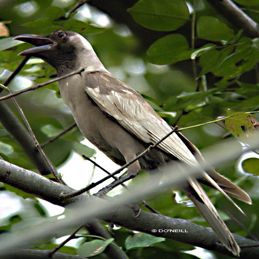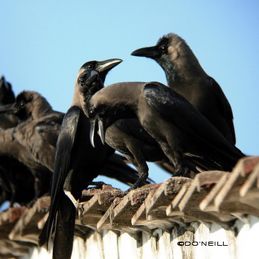A pair of House Crows (Corvus splendens) was observed in a residential area perched on a television antenna. One was black and the other was a light brown colour- and that was something odd (below left).
Let’s listen in.
“Ma, why am I so different?”
“Did I fall into a bucket of bleach?” asked the juvenile crow in sepia.
“No…, you did not and I don’t know why you were born like this, dear. And that makes you even more special!” replied the black House Crow as she proceeded to preen her chick tenderly.
Feather shafts of birds sink into the skin organ to receive the necessary nourishment for growth and endowment of birds’ plumages. Colours of feathers are determined by the genetic make up and quantity distribution of pigmentation cells present in the skin.
Leucism in birds is a genetic disorder whereby the pigmentation cells are unevenly distributed, hence resulting in patches of feathers looking paler, bleached looking or show white. (While Albinism dictates that the skin body is totally devoid of pigmentation cell. Hence, if one looks into the iris of an albino, it always shows reddish-pink or near equivalent.)
The image (above right) shows an adult leucistic House Crow. Note especially the uneven discolouration of the beak, white naped patch and wings and dark eyes to compare with a flock of normal House Crows (below left).
It was also observed that the leucistic House Crow was treated as an out-caste and chased off by other crows while the former was scavenging and ate lunch (above right).
It is not a common phenomenon and science has yet to figure out why leucism occurs. Perhaps… it is one of those things that Mother Nature, the divine architect sees fit – to be allowed to mastermind mistakes now and then!
And which ascertain that in our world, nothing and nobody is perfect… and we be allowed to do so sometimes too.
Three sightings of leucistic House Crows were made in 2008 at the same location.
AVIAN WRITER DAISY O’NEILL PENANG MALAYSIA
© LEUCISM IN CROWS













9 Responses
Hi YC, Daisy
I posted about leucism with some interesting photos on the 10,000 Birds blog at http://10000birds.com/mystery-bird-on-kauai-hawaii.htm – I’ve linked here but I was wondering if I could get permission to add your photo of the House Crow to our post? I’ll of course add all links/credits etc.
Thanks
Charlie
Have contacted Daisy for her permission.
I have sen 2 leucistic crows in Sheffield (UK) today (17/6/10)
I wondered why they were such a strange colour and assumed that this was common in jeuvenile crows – but then wondered why I’d never observed it before – hence the search.
We had a pair crows nest in the hoop pine adjacent to our house in December 2012. This is in Brisbane Australia. They appear to have hatched a leucistic junvenile. I think our crows are quite large an up to 400mm tall. The chick is the same size but light grey/brown in colour with alternating grey/white and brown stripes on the underside of the tail feathers. I though it might have been a cuckoo but the size and shape of the head is distinctly crow like. I am glad to see that it is surviving. Interstingly, the murder of crows (about 15 of the buggers) that once used to come to our iron bark at 5am in the morning and yell at the top of their voices, have not come around this year. Perhaps the murder is ostracizing the leucistic crow. At least it is quieter.
Yes, they normally do ostracise.